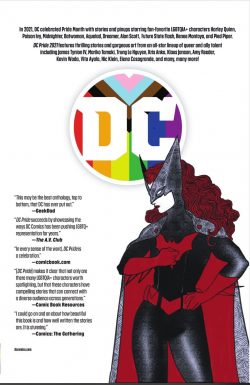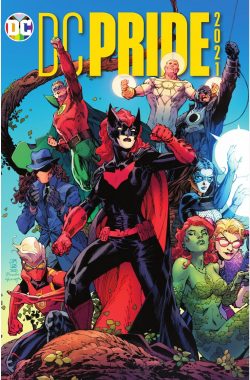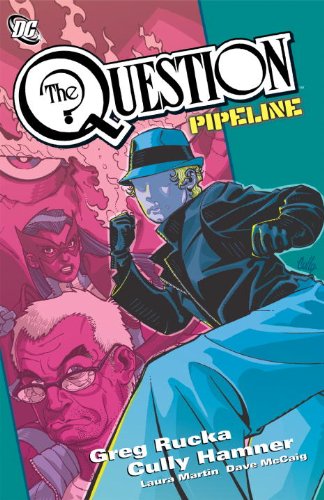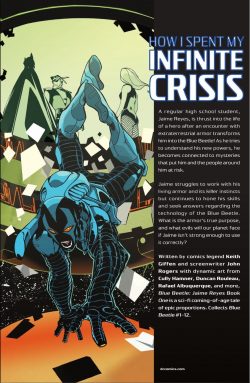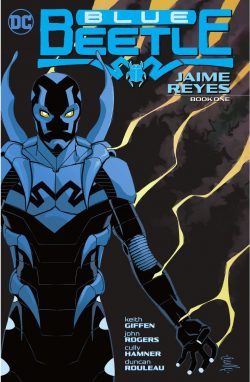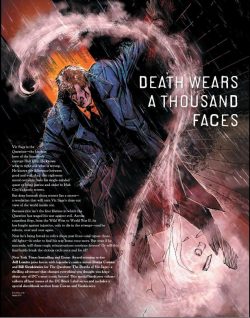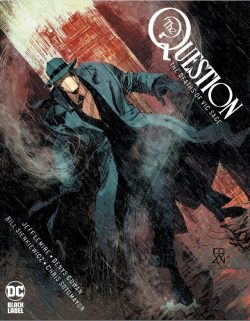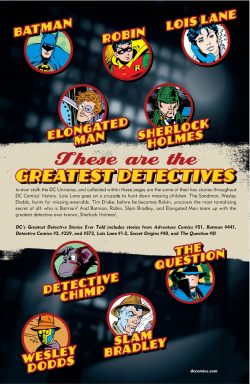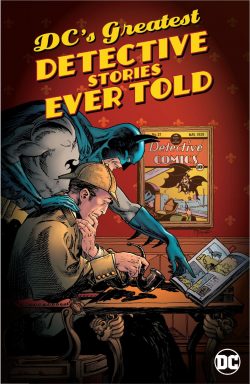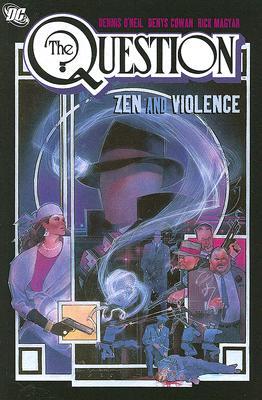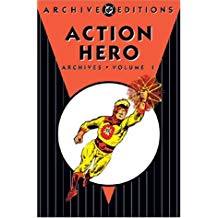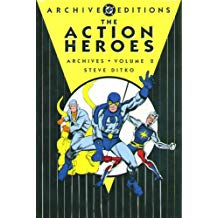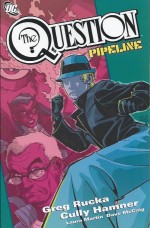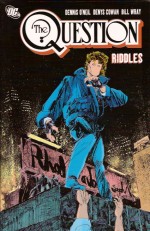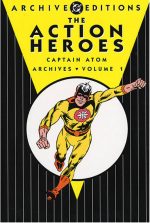
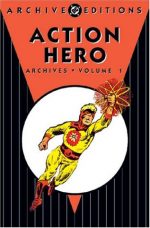
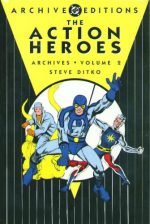
By Steve Ditko, Joe Gill, Gary Friedrich, Dave Kaler, Steve Skeates, Rocke Mastroserio, Frank McLaughlin, Al Milgrom, Roger Stern, John Byrne, Michael Uslan, Alex Toth, and various (DC Comics)
ISBN: 978-1-4012-0302-3 (HB vol. 1) 978-1-4012-1346-6 (HB vol. 2)
Clearly I’m cashing in on the pre-release hype around a new DC Cinema blockbuster here, but I take honest refuge and some comfort in the fact that these books and the stories they contain are actually germane as well as being some of the best Silver Age comics ever crafted…
Despite being dead – and so very much missed – Steve Ditko remains comics’ most unique stylist. Love him or hate him, you can’t mistake his work for anyone else’s. His career began in the early 1950s and, depending on whether you’re a superhero fan or prefer deeper, more challenging experimental work, peaked in either the mid-1960s or 1970s.
Leaving the Avenging World, Mr. A and his other philosophically-derived creations for another time, the superhero crowd should heartily celebrate and clamour for new editions of these deluxe collections of the first costumed do-gooder that Ditko worked on. Although I’m a huge fan of his linework – which is always best served by monochrome printing – the crisp, sharp colour of these Archive editions is still much better than the appalling reproduction on bog-paper that first displayed Charlton Comics’ Atomic Ace and latterly the Bug Bombshell to the kids of Commie-obsessed America.
As discussed in the Foreword by historian and Ditko-expert Blake Bell, Action Heroes Archive volume 1: Captain Atom reveals – in all the full-on, simplistic furore of a 1950s B-Movie – how a Cold War-obsessed America copes with a modern-day miracle just as the concept of costumed superheroes was being reimagined…
With covers by Ditko and/or Mastroserio, this tome amasses pertinent tales from Space Adventures #33-40 & 42 (spanning cover-dates March 1960 to October 1961), augmented by the contents of the revived, solo-starring Captain Atom #78-82, as published for December 1965 through September 1966.
In those simpler times the short, terse adventures of Captain Atom seemed somehow more telling than the innovative yet rather anodyne DC fare, whilst Marvel was still pushing romances, westerns and monsters in underpants, explorers in pith helmets and citizen scientists with labs in their garden sheds. Their particular heroic revolution was still months away even though Steve Ditko was producing top-flight work for both companies.
Nevertheless, Ditko’s hero was different and we few who read him all knew it….
As scripted by Jo Gill and predating Fantastic Four #1 by more than 18 months, Space Adventures #33 even cover-featured the new sensation-in-waiting as ‘Introducing Captain Atom’ in a brief but vivid vignette, giving us a true American hero and man of his time before instantly killing him.
Captain Adam was an astronaut accidentally but literally atomised in a rocketry accident. Eerily – and the way it’s drawn spooked the short pants off me when I first read it all those years ago – he gradually reassembles himself on the launch pad…
Now blessed with astounding powers, he reports to the President (Eisenhower) and is swiftly kitted up in a protective outfit, allowing contact with normal, non-irradiated humans and reassigned as a masked superhero who will be the USA’s secret weapon…
Mostly written by or co-written with Joe Gill, the first wonderful, addictive run of 18 stories from Space Adventures #33-42 (and three of those were in fact drawn by uninspired, out-of-his-comfort zone Rocke Mastroserio) are a magnificent example of Ditko’s emerging mastery of mood, pacing, atmosphere and human dynamics.
In 1961, with Ditko increasingly doing more work for blossoming – and better paying – Marvel, Charlton killed the Captain Atom feature. However, when Dick Giordano jumped on the superhero bandwagon and created a costumed character line for Charlton in late 1965, the Captain was revived. Space Adventures was retitled, with Atom’s first full length issue numbered #78.
Since he was still drawing Amazing Spider-Man and Doctor Strange, Ditko could only manage pencils, so Mastroserio was recruited to ink the series, resulting in an oddly jarring finish. With #79, Ditko became lead writer too, and the stories took on an eccentric, compelling edge and tone, lifting them above much of the competition’s fare. Eventually the inker adapted to Ditko’s style and much of the ungainliness disappeared from the figurework, although so had the fine detail that had elevated the early art. This volume ends with issue #82, leaving six more published issues and a complete unpublished seventh for another time…
However, those early, Cold War-fired tales are a truly unique blend of action, tension and sheer whimsy which continued in Space Adventures #34 as ‘The 2nd Man in Space’ cheekily sees the magnanimous hero covertly undercut another Soviet space triumph by saving the USSR’s first cosmonaut from his defective capsule, whilst #35#s ‘The Little Wanderer’ finds him traversing the stars to rescue the spirit of an little boy inadvertently abducted by a well-meaning cosmic traveller…
A thermonuclear double bill graced #36, beginning with ‘The Wreck of X-44’, with a new craft detonating in space and leading Captain Atom to a deadly saboteur, after which ‘Captain Atom on Planet X’ finds him defending a US satellite from all-out attack by the dastardly ruthless Russians…
Geopolitics gives way to fantasy as #37 (December 1960) initially details a fusion-foiled invasion by ‘The Space Prowlers’ before a US probe to the second planet is scuttled by svelte space sirens who score ‘A Victory for Venus’ over the stounded atomic Earthman…
Two months later and the count climbed to three stories, beginning with ‘One Second of War’, wherein the Captain wrecks the doomsday missile attack of Dr. Claudius Jaynes, a suicidal maniac with his own atomic arsenal, before repeating the feat in ‘Backfire’ when a tin-pot dictator seeks to nuke the USA. The issue ends with ‘The Force Beyond’ as an alien entity tries to destroy the world with meteors before encountering our nuclear nemesis…
Space Adventures #39 begins with a ‘Test-Pilot’s Nightmare’ as arrogance threatens the life of a helpless jet jockey and Atom invisibly comes to the rescue after which Mastroserio limns ‘Peace Envoy’ with the energetic enigma turning back another alien invasion. Ditko is back for the final fling as Captain Adam goes undercover in Berlin (just before The Wall went up) to crush an espionage plot in ‘An Ageless Weapon’…
The atomic experiment was coming to a close. After #40’s ‘The Crisis’ – wherein the hero helps a diplomat call a tyrant’s bluff and ‘The Boy and the Stars’ features another Earth tot transported into the wondrous cosmos – the costumed heroics were absent the next issue.
Just as the FF was about to go big, Space Adventures #42 (October 1961) arrived and depleted all the inventory tales at once beginning with a brace of Mastroserio drawn yarns and one last tantalising Ditko masterpiece. ‘The Saucer Scare’ is yet another mediocre space war clash whilst ‘The Man in Saturn’s Moon’ sees the atomic ace hunting a Soviet dissent squirreled away by wicked commies. Those lesser efforts are utterly eclipsed by ‘The Silver Lady from Venus’ as another sexy extraterrestrial beguiles the humans of Earth before making a fool of the fiery champion…
And that was that the end until of 1965 when a global resurgence of costumed capers led to a new line at Charlton. Leading that charge came Captain Atom #78 (cover-dated December) when Gill & Ditko – with Mastroserio inking – revived the Atomic Adventurer in ‘The Gremlins from Planet Blue’. The genre had moved on in four years and the stripped-back, pared-down B-Movie feel of those early tales had evolved into a more uniquely fulsome and flamboyant affair for this particular extraterrestrial infiltration. Here were subplots and supporting cast to spare, as the hero foiled alien sabotage and mind control at Cape Kennedy, romancing Leah Jupe whilst her scientist father fell under the control of insidious infiltrators. There was even a new gadfly for Captain Adam in the grumpy form of martinet military man General Brill before ultimately saving Earth again…
In the next issue (February/March 1966), a true but tragic supervillain arrives in the series as ‘Captain Atom Faces Doctor Spectro, Master of Moods’ when a spy hunt brings the hero into the orbit of an embittered recluse seeking to master light and colour to revolutionise medicine. Sadly, sudden success tips him over the edge and his newfound abilities drive him even more crazy…
Apparently destroyed, the miscreant is soon forgotten when a wandering planetoid nears Earth and sounds the ‘Death Knell of the World’ (#80, Ditko, Gill & Mastroserio). Happily, the High Energy Hero is up to foiling a cosmic tyrant and liberating his captive satellite people before confronting ‘The Five Faces of Doctor Spectro’ as the misunderstood miscreant reappears in five prismatic pieces with a plethora of different plans but one overriding goal: pulling himself together and finally splitting this atom…
The hero hosts a quick fact feature drawn by Frank McLaughlin in ‘Captain Atom’s Secret’ before this initial outing ends with a magnificent step up in tension and quality. Issue #82 – cover-dated September 1966 and by Ditko with Dave Kaler & Mastroserio – debuts not just the series’ ultimate archfoe and a major story arc but also the company’s first female superhero.
With an enigmatic teleporting thief casually robbing the nation and the military of its wealth and top secrets, Captain Adam is sent undercover with mystery operative Nightshade in ‘Captain Atom vs. The Ghost’…
Their mission introduces sleek scoundrel Alec Rois, channels the spy craze of the era and hints at a vast conspiracy underpinning a threat to Earth and even finds time to see the heroes battle an army of thugs and save Fort Knox from bold bullion banditry…
Over half a decade pioneers Steve Ditko and Captain Atom and paved the way and lit a path to a revolution in comics storytelling and these early exploits were only the start…
Action Heroes volume 2: Captain Atom, Blue Beetle & The Question
A second – far longer – volume completes Ditko’s controversial Charlton Comics costumed hero contributions with the remainder of Captain Atom’s exploits, the introduction of a new Blue Beetle and debut of his uniquely iconic vigilante The Question.
Following an effusive and extremely informative Introduction by original Action Line inventor and editor Dick Giordano, Captain Atom #83 (November 1966) starts the ball rolling again with a huge blast of reconstructive character surgery.
Although ‘Finally Falls the Mighty!’ was inked by Mastroserio and scripted by relative newcomer Kaler, thematically it’s pure Ditko. Plotted and drawn by him, it sees an ungrateful public swiftly turn on the Atomic Ace, due to the manipulations of a former colleague turned cunning criminal.
Intended to tone down the character’s sheer omnipotence, the added approachable empathy-inducing humanity of malfunctioning powers made his struggles against treacherous Professor Koste all the more poignant.
Moreover, the sheer visual spectacle of his battle against a runaway reactor is some of Ditko’s most imaginative design and layout work. The tale ends on a cliffhanger – a real big deal when the comic came out every two months – and with the last 7 pages dedicated to debuting a new superhero with one of the oldest names in the business.
The Blue Beetle first appeared in Mystery Men Comics #1, released by Fox Comics and cover-dated August 1939. Created by Charles Nicholas (nee Wojtkowski) the character was inexplicably popular: surviving the collapse of numerous publishers before ending up as an acquired Charlton property in the mid-1950s. After releasing a few issues sporadically, Charlton shelved him until the superhero revival of the 1960s when Gill and latterly young Roy Thomas revised and revived the character for a combined 10-issue run (June 1964 – February 1966).
Here however, Ditko accepts but sets aside all that history to utterly recreate him. Ted Kord is an earnest young scientist with a secret tragedy in his past, which Ditko and scripter Gary Friedrich sagely forbear revealing in deference to intrigue and action, in a taut, captivating crime-thriller where the new hero displays his modus operandi by stopping a vicious crime-spree by the Killer Koke Gang.
This untitled short has all the classic elements of a Ditko masterpiece: outlandish intense, fight scenes, compact, claustrophobic yet dynamic layouts, innovative gimmickry and a clear-cut battle between Right and Wrong. It’s one of the very best introductory stories of a new hero anywhere in comics – and it’s 7 pages long…
The remodelling of the Atomic Ace concludes in the next issue with ‘After the Fall a New Beginning’. Once again Ditko rattled his authorial sabre about the fickleness of the public as the villainous Koste exposes the hero’s face on live TV. Escaping, Atom gets a new costume to match his curtailed powers …and consequently, a lot more drama drapes the series.
Now there is a definite feeling of no safety or status quo. The untitled Blue Beetle back-up (scripted by Friedrich with full art from Ditko) pits the new kid against a Masked Marauder, but the real kicker is the bombshell revelation that Homicide detective Fisher – investigating the disappearance of Dan Garrett – suspects a possible connection to Kord…
Whilst extending a running plot-line about the mysterious Ghost and his connection to a lost civilization of warrior women, ‘Strings of Punch and Jewelee’ introduces a couple of shady carnival hucksters who find a chest of esoteric alien weapons and use them for robbery. Although Cap and partner Nightshade are somewhat outclassed here, the vigour and vitality of the Blue Beetle is again undeniable as a mid-air hijack is foiled and a spy sub and giant killer octopus are given short shrift by the indomitable rookie crusader.
Captain Atom #86 finally brings the long-simmering plot-thread of tech thief The Ghost to a boil as the malevolent science-wizard goes on a rampage, totally trouncing Nightshade and our hero before being kidnapped by the aforementioned mystery maidens. ‘The Fury of the Faceless Foe! is by Ditko, Kaler & Mastroserio whilst in the (still) untitled Blue Beetle strip by Friedrich & Ditko, the cobalt crusader confronts a ruthless scientist/industrial spy he’s convinced he battled before…
This leads directly into the first issue of his own comic book. Blue Beetle #1 (cover-dated June 1967) is an all-Ditko masterpiece (even scripting it as “D.C. Glanzman”) with the hero in all-out action against a deadly gang of bandits. ‘Blue Beetle… Bugs the Squids’ is crammed with the eccentric vitality that made Amazing Spider-Man such a monster hit, with justice-dispensing joie de vivre balanced by the moody, claustrophobic introduction of Ditko’s most challenging mainstream superhero creation.
‘The Question’ is Vic Sage, a TV journalist with an uncompromising attitude to crime and corruption, employing an alter-ego of faceless, relentless retribution. In his premiere outing he exposes the link between his own employers’ self-righteous sponsors and gambling racketeer Lou Dicer. This theme of unflinching virtue in the teeth of both violent crime and pernicious peer and public pressure marked Ditko’s departure from straight entertainment towards philosophical – some would say polemical – examination of greater societal issues and the true nature of both Good and Evil that would culminate in his controversial Mr. A, Avenging World and other independent ventures.
In Captain Atom #87 (August 1967), ‘The Menace of the Fiery-Icer’ presaged the beginning of the end for the Atomic Ace as Kaler, Ditko & Mastroserio dialled back on plot threads to deliver a visually excellent but run-of-the-mill yarn about a spy ring with a hot line in cold-blooded leaders.
Blue Beetle #2 however – another all-Ditko affair from the same month – showed the master at his peak. Lead story ‘The End is a Beginning!’ at last reveals the origin of the character as well as the fate of Dan Garrett, and even advances Kord’s relationship with his assistant Tracey. The enigmatic Question, meanwhile, tackles flying burglar The Banshee in a vertiginous, moody thriller reminiscent of early Doctor Strange strips.
Frank McLaughlin joins as inker for a satisfying no-nonsense escapist romp ‘Ravage of Ronthor’ (Captain Atom #88, October 1967), as the hero answers a distress call from space to preserve a paradise planet from marauding giant bugs. Blue Beetle #3 was another superbly satisfying read, as the eponymous hero routes malevolent, picturesque thugs ‘The Madmen’ in a sharp parable about paranoia and misperception. Equally captivating is the intense and bizarre Question vignette wherein a murderous ghostly deep-sea diver stalks some shady captains of industry…
Cover-dated December 1967, issue #89 was the last Captain Atom published by Charlton: an early casualty of the burn-out afflicting the superhero genre and leading to a resurrected horror and mystery craze. This resurrected genre would form a new backbone for the company’s 1970’s output; one where Ditko would shine again in his role as master of short story horror.
Scripter Kaler satisfactorily ties up most of the hanging plot threads with the warrior women of Sunuria in sci-fi-meets-witchcraft thriller ‘Thirteen’, although the Ditko/McLaughlin art team was nowhere near top form.
The next episode promised a final ‘Showdown in Sunuria’, but never materialized…
Blue Beetle #4 (released the same month) is visually the best of the bunch as Kord follows a somehow-returned Dan Garrett to an Asian backwater in pursuit of lost treasure and a death cult. ‘The Men of the Mask’ is pure strip poetry and bombastic action, cunningly counterbalanced by a seedy underworld thriller as the Question seeks to discover who gave the order to ‘Kill Vic Sage!’ Scripted by Steve Skeates (as Warren Savin) it was the last action any Charlton hero saw for the better part of a year…
Then, cover-dated October 1968, The Question returned as the star of Mysterious Suspense #1, with Ditko producing a captivating cover and three-chapter thriller (with Mastroserio providing a rather jarring full-page frontispiece). ‘What Makes a Hero?’ (probably rescued from partially completed inventory material) sees crusading Vic Sage pilloried by the public, abandoned by friends and abandoned by his employers yet resolutely sticking to his higher principles in pursuit of hypocritical villains masquerading as pillars of the community. Ditko’s interest in Ayn Rand’s philosophical Objectivism had become increasingly important to him and this story is arguably the dividing line between his “old” and “new” work. It’s also the most powerful and compelling piece in this entire book.
A month later one final issue of Blue Beetle (#5) was published. ‘The Destroyer of Heroes’ is a decidedly quirky tale featuring a nominal team-up of the azure avenger and the Question as a frustrated artist defaces heroic and uplifting paintings and statues. Ditko’s committed if reactionary views of youth culture, which so worried Stan Lee, are fully on view in this charged, absorbing tale.
Other material had been created and languished incomplete in editorial limbo. In the early 1970s a burgeoning and committed fan-base created fanzine Charlton Portfolio. With the willing assistance of the company, a host of kids who would soon become household names in their own right found a way to bring the lost work to the public gaze. Their efforts are also included here, in monochrome as they originally appeared.
For Charlton Portfolio #9 and 10 (1974), the unreleased Blue Beetle #6 was serialized. ‘A Specter is Haunting Hub City!’ is another all-Ditko extravaganza, pitting the hero against an (almost) invisible thief. Follow-up magazine Charlton Bullseye (1975) finally published ‘Showdown in Sunuria’ in its first two issues.
Behind an Al Milgrom Captain Atom cover, Kaler’s plot was scripted by Roger Stern (working as Jon G. Michels) and Ditko’s pencils were inked by rising star John Byrne – a cataclysmic climax almost worth the 8-year wait. But even there, the magic doesn’t end in this magnificent Archive volume.
Charlton Bullseye #5 (1975) offers one last pre-DC tale of The Question: 8 gripping, intense and beautiful pages plotted by Stern, scripted by Michael Uslan and illustrated by the legendary Alex Toth. This alone is worth the price of admission.
These weighty snapshots from another era are packed with classic material by brilliant craftsmen. They are books no Ditko addict, serious fan of the genre or lover of graphic adventure can afford to be without. It’s impossible to describe the grace, finesse, and unique eclectic shape of Steve Ditko’s art. It must be experienced, and this is as good a place to start as any. It’s just a shame DC have let these tales languish so long, but hopefully the power of Hollywood will induce a revival…
© 1966, 1967, 1968, 1974, 1975, 1976, 2007 DC Comics. All Rights Reserved.
